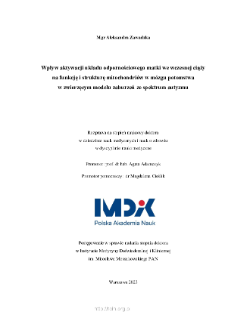- Wyszukaj w całym Repozytorium
- Piśmiennictwo i mapy
- Archeologia
- Baza Młynów
- Nauki przyrodnicze
Wyszukiwanie zaawansowane
Wyszukiwanie zaawansowane
Wyszukiwanie zaawansowane
Wyszukiwanie zaawansowane
Wyszukiwanie zaawansowane

Obiekt
Tytuł: Wpływ aktywacji układu odpornościowego matki we wczesnej ciąży na funkcję i strukturę mitochondriów w mózgu potomstwa w zwierzęcym modelu zaburzeń ze spektrum autyzmu
Twórca instytucjonalny:
Instytut Medycyny Doświadczalnej i Klinicznej im. M. Mossakowskiego PAN
Współtwórca:
Adamczyk, Agata (Promotor) ; Cieślik, Magdalena (Promotor pomocniczy)
Wydawca:
Instytut Medycyny Doświadczalnej i Klinicznej im. M. Mossakowskiego PAN
Miejsce wydania:
Uzyskany tytuł:
Stopień studiów:
Dyscyplina :
Instytucja nadająca tytuł:
Mossakowski Medical Research Institute Polish Academy of Sciences
Typ obiektu:
Abstrakt:
Autism spectrum disorders (ASD) are a diverse group of neurodevelopmental disorders, Leading theory states that ASD occurs as a result of influence of both genetic and environmental factors, including prenatal stress, such as maternal immune activation (MIA) during pregnancy, what was confirmed by epidemiological studies. Moreover, animals prenatally exposed to MIA show ASD-like behaviors later in life. Up until now, no research would focus of mitochondrial functioning in the brain of MIA offspring, even though mitochondrial dysfunction has been diagnosed in ASD patients. Therefore, the aim of this research was to test the hypothesis that mitochondrial dysfunction occurs in ASD caused by maternal immune activation. In this research, animal model of MIA was induced by injection of lipopolysaccharide (LPS, 100 µg/kg b.w.) to pregnant Wistar rat at day 9.5 of pregnancy. Experiments were conducted using immunochemical, luminescent, spectrophotometric, spectrofluorimetric and microscopic methods. Behavioral tests were also performed. Is was showed that LPS injection causes increase in expression of Il1b, Il6, Ifng and Tnf, NADPH oxidase (NOX) activation and increase in reactive oxygen species (ROS) in fetal tissue. Moreover, decreased mitochondrial membrane potential and ATP levels were observed. Behavioral tests revealed ASD-like changes in behavior. Infants at 10-11 postnatal vocalized less when isolated form family, and at postnatal day 15, MIA offspring showed less interest in home odor. Young adults (postnatal day 50) showed decreased sociability and decreased interest in social novelty. Expression of Il1b and Ifng was increased in the brain of infants prenatally exposed to MIA. At the same time, increased activity of NOX and high levels of ROS were observed. Additionally, decreased mitochondrial membrane potential and ATP levels were observed, even though there were no changes in activity or expression of mitochondrial electron transport chain. Moreover, despite observed changes in mitochondrial membrane potential, there was no difference in mitochondria content or levels of proteins involved in PINK1/parkin-dependent mitophagy. Finally, increased expression of genes for mitochondrial dynamics and biogenesis suggests some compensation mechanism, in response to cellular stress. Increased expression of Il6, Tnf, Ptgs2 and Alox12 was demonstrated in cerebral cortex of MIA animals, which was accompanied by microglia activation. Such effect was not observed in hippocampus. Both structures showed increased ROS levels, and decreased GSH/GSSG ratio. However, only in hippocampus high activity of NOX was observed. It seems that mitochondria are disturbed at this time point in a structure-dependent matter. In cerebral cortex both expression and activity of three mitochondrial complexes (CI (mt-Nd1), CIII (mt-Cyb) and CIV(mt-Co1)) were decreased, whereas in hippocampus decreased expression of mt-Nd1 and mt-Co1 and activity of CI and CIII were observed. Moreover, it was demonstrated that mitochondrial membrane potential and ATP levels decreased in both structures, and in cerebral cortex fragmentation was increased, with no change in mitophagy. Finally, analysis with transmission electron microscopy revealed many changes in mitochondrial ultrastructure, including blurred cristae and mitochondrial membrane, and signs of mitochondrial swelling, in both structures. To conclude, obtained results indicate that activation of the maternal immune system during pregnancy causes disturbance in mitochondrial functioning and ultrastructure in brain of the offspring, in an age-dependent and structure-dependent manner. It seems that mitochondria might be an attractive target for potential therapeutical intervention in ASD induced by maternal immune activation during pregnancy.
Szczegółowy typ zasobu:
Format:
Identyfikator zasobu:
Źródło:
IMDiK PAN, sygn. ZS 428 ; kliknij tutaj, żeby przejść
Język:
Język streszczenia:
Prawa:
Creative Commons Attribution BY 4.0 license
Zasady wykorzystania:
Copyright-protected material. [CC BY 4.0] May be used within the scope specified in Creative Commons Attribution BY 4.0 license, full text available at: ; -
Digitalizacja:
Mossakowski Medical Research Institute PAS
Lokalizacja oryginału:
Library of the Mossakowski Medical Research Institute PAS
Dofinansowane ze środków:
Dostęp:
Kolekcje, do których przypisany jest obiekt:
- Repozytorium Cyfrowe Instytutów Naukowych > Kolekcje Partnerów > Instytut Medycyny Doświadczalnej i Klinicznej PAN > Prace dyplomowe > Prace doktorskie
- Repozytorium Cyfrowe Instytutów Naukowych > Piśmiennictwo > Prace dyplomowe
Data ostatniej modyfikacji:
21 lis 2024
Data dodania obiektu:
28 gru 2023
Liczba pobrań / odtworzeń:
117
Wszystkie dostępne wersje tego obiektu:
https://rcin.org.pl./publication/276438

 INSTYTUT ARCHEOLOGII I ETNOLOGII POLSKIEJ AKADEMII NAUK
INSTYTUT ARCHEOLOGII I ETNOLOGII POLSKIEJ AKADEMII NAUK
 INSTYTUT BADAŃ LITERACKICH POLSKIEJ AKADEMII NAUK
INSTYTUT BADAŃ LITERACKICH POLSKIEJ AKADEMII NAUK
 INSTYTUT BADAWCZY LEŚNICTWA
INSTYTUT BADAWCZY LEŚNICTWA
 INSTYTUT BIOLOGII DOŚWIADCZALNEJ IM. MARCELEGO NENCKIEGO POLSKIEJ AKADEMII NAUK
INSTYTUT BIOLOGII DOŚWIADCZALNEJ IM. MARCELEGO NENCKIEGO POLSKIEJ AKADEMII NAUK
 INSTYTUT BIOLOGII SSAKÓW POLSKIEJ AKADEMII NAUK
INSTYTUT BIOLOGII SSAKÓW POLSKIEJ AKADEMII NAUK
 INSTYTUT CHEMII FIZYCZNEJ PAN
INSTYTUT CHEMII FIZYCZNEJ PAN
 INSTYTUT CHEMII ORGANICZNEJ PAN
INSTYTUT CHEMII ORGANICZNEJ PAN
 INSTYTUT FILOZOFII I SOCJOLOGII PAN
INSTYTUT FILOZOFII I SOCJOLOGII PAN
 INSTYTUT GEOGRAFII I PRZESTRZENNEGO ZAGOSPODAROWANIA PAN
INSTYTUT GEOGRAFII I PRZESTRZENNEGO ZAGOSPODAROWANIA PAN
 INSTYTUT HISTORII im. TADEUSZA MANTEUFFLA POLSKIEJ AKADEMII NAUK
INSTYTUT HISTORII im. TADEUSZA MANTEUFFLA POLSKIEJ AKADEMII NAUK
 INSTYTUT JĘZYKA POLSKIEGO POLSKIEJ AKADEMII NAUK
INSTYTUT JĘZYKA POLSKIEGO POLSKIEJ AKADEMII NAUK
 INSTYTUT MATEMATYCZNY PAN
INSTYTUT MATEMATYCZNY PAN
 INSTYTUT MEDYCYNY DOŚWIADCZALNEJ I KLINICZNEJ IM.MIROSŁAWA MOSSAKOWSKIEGO POLSKIEJ AKADEMII NAUK
INSTYTUT MEDYCYNY DOŚWIADCZALNEJ I KLINICZNEJ IM.MIROSŁAWA MOSSAKOWSKIEGO POLSKIEJ AKADEMII NAUK
 INSTYTUT PODSTAWOWYCH PROBLEMÓW TECHNIKI PAN
INSTYTUT PODSTAWOWYCH PROBLEMÓW TECHNIKI PAN
 INSTYTUT SLAWISTYKI PAN
INSTYTUT SLAWISTYKI PAN
 SIEĆ BADAWCZA ŁUKASIEWICZ - INSTYTUT TECHNOLOGII MATERIAŁÓW ELEKTRONICZNYCH
SIEĆ BADAWCZA ŁUKASIEWICZ - INSTYTUT TECHNOLOGII MATERIAŁÓW ELEKTRONICZNYCH
 MUZEUM I INSTYTUT ZOOLOGII POLSKIEJ AKADEMII NAUK
MUZEUM I INSTYTUT ZOOLOGII POLSKIEJ AKADEMII NAUK
 INSTYTUT BADAŃ SYSTEMOWYCH PAN
INSTYTUT BADAŃ SYSTEMOWYCH PAN
 INSTYTUT BOTANIKI IM. WŁADYSŁAWA SZAFERA POLSKIEJ AKADEMII NAUK
INSTYTUT BOTANIKI IM. WŁADYSŁAWA SZAFERA POLSKIEJ AKADEMII NAUK


































